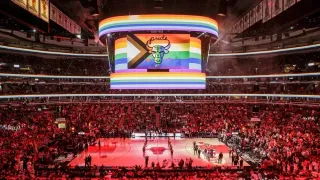
3 hours ago
Airyn De Niro Steps Into the Light: Transition, Family, and the Power of Being Seen
READ TIME: 3 MIN.
It’s not every day that a new voice emerges from Hollywood royalty—especially one as refreshingly honest and vibrantly queer as Airyn De Niro’s. At 29, the daughter of Oscar-winner Robert De Niro and trailblazing Black model Toukie Smith has taken the rare step of sharing her transition as a transgender woman with the world, offering a story that’s equal parts heartfelt, vulnerable, and unflinchingly real .
Her coming out isn’t just celebrity news—it’s a seismic moment for visibility, representation, and affirmation, especially for those living at the intersection of Black and trans identities. In an interview with Them Magazine, Airyn spoke about her “late-blooming” journey, her struggles to find acceptance—both within her family and herself—and the ways in which her transition has deepened her pride in her Blackness .
If you’re thinking Airyn’s story is all glitz and easy acceptance, think again. For years, she preferred discretion, keeping her truth close—even as paparazzi snaps and tabloid headlines threatened to “out” her before she was ready. The public revelation came after photos published in the Daily Mail showed Airyn by her father’s side, “dressed as a woman, in high heels and long pink dreadlocks,” a look described by some as “shocking”—but which, for many trans people, is nothing short of radical joy .
“I’d want to hopefully be an inspiration for at least one other person like me,” Airyn said, her voice resonating with the hope and courage that comes from hard-won self-acceptance . Family, she admits, played a crucial role. While she’s grateful that her parents shielded her and her twin brother Julian from media scrutiny and accepted her “homosexual nature,” she also voices a longing for the kind of unconditional affirmation that so many queer youth crave: “I would have liked someone to tell me, ‘You’re fine just as you are.’”
It’s a sentiment that lands especially hard for LGBTQ+ readers who know the bittersweet difference between being “visible” and truly being “seen.” Airyn describes growing up as a biracial, plus-size kid in a famous, mostly white family—feeling “too big, not thin enough, not Black enough, not white enough. Too feminine, not masculine enough.” Her candor about dysmorphia and desirability echoes the complex, often unspoken struggles that many queer and trans people face as they search for self-worth in a world obsessed with narrow ideals .
What makes Airyn’s story especially resonant is her embrace of intersectionality. “A big part of my transition is the influence Black women have had on me. Stepping into this new identity, while also being more proud of my Blackness, makes me feel closer to them in some way,” she told Them Magazine . For Airyn, icons like Laverne Cox, Michaela Jaé Rodriguez, and Jools Lebron weren’t just celebrities—they were living proof that being unapologetically trans and Black is not only possible but a powerful act of courage.
Her late start with hormone therapy, which began in November 2024, underscores the reality that there’s no expiration date on self-discovery. “Trans women being honest and open, especially in public spaces like social media and getting to see them in their success. I’m like, you know what? Maybe it’s not too late for me. Maybe I can start,” she reflected .
For those who worry that Hollywood doors swing open for famous last names, Airyn’s experience has been a reminder that trans and queer people—even those with star power—still face skepticism and exclusion. Despite her lineage, casting agents remain hesitant to offer her roles. Instead, she’s forging her own path in voice acting and modeling, while also pursuing a degree in mental health counseling—a calling rooted in her desire to support “people of color and queer people who really need more advocacy and support in mental health” .
In a moment when trans rights are under attack, and visibility can be both a shield and a target, Airyn’s story lands as a powerful reminder of what’s at stake. Her journey is more than a celebrity coming out—it’s a tender, triumphant refusal to let anyone else define her. It’s about finding joy in spaces that once felt forbidden, and about the revolutionary act of saying, “I deserve to be seen.”
Airyn’s hope—to inspire even one other Black, queer, non-XS person—is a rallying cry for anyone who’s ever felt “too much” or “not enough.” Her willingness to speak out, to share the messy, beautiful reality of transition, and to call for mental health advocacy for marginalized communities is exactly the kind of leadership the queer world needs right now.
If you’re reading this and feeling the weight of your own “late bloom,” Airyn’s message is clear: It’s never too late to start. There’s power in being visible, but there’s magic in truly being seen.






